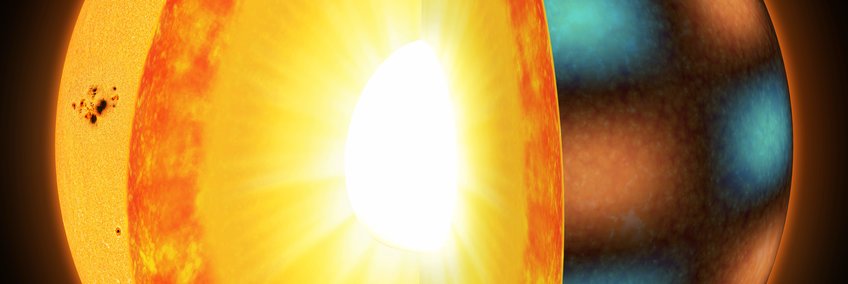
Research Topics
1. Sun
Research Area
Helioseismology, the use of solar oscillations to measure physical conditions in the solar interior, includes a wide range of methods. Global helioseismology is based on measuring and interpreting the resonant frequencies of the global acoustic oscillations of the Sun and allows us to study axisymmetric properties of the Sun such as internal differential rotation. Local helioseismology involves measuring the correlations of the surface wave field and allows three dimensional probing of the solar interior, as well as access to additional flow components such as the north-south meridional flow. In our department, we develop and apply both global and local methods of helioseismology; this involves solving the forward and inverse problems with the help of applied mathematicians. This work benefits from an active collaboration with Inria Bordeaux .
Helioseismology inferences are combined with physical and numerical models of the solar interior to better understand the global dynamics of the solar convection zone and the solar dynamo. Current efforts include the development of models of solar magnetoconvection in spherical shells and flux-transport models of the solar cycle.
Major Projects
Solar Dynamics Observatory, WholeSun ERC Synergy project, German Data Center for SDO, Solar Orbiter, collaboration with Max Planck Fellow Group Inverse Problems, SFB Mathematics of Experiments.
Selected Major Results
- The solar meridional circulation is one cell in each hemisphere.
- Towards models of solar Rossby modes
- Solar active regions develop tilt after emergence
- Four billion years of solar-cycle irradiance variations
- GIant swirls on the Sun (2018)
- Slow appearance of sunspots challenges theory (2016)
2. Stars and Planetary Systems
Research Area
We study stellar rotation and activity using asteroseismology and photometric variability. Measurements of rotation and differential rotation, in combination with observations of stellar activity, provide strong constraints on dynamo models. Unfortunately, the internal differential rotation of any single Sun-like star is often poorly constrained by observations. The full sample of Kepler stars (later PLATO) which includes evolved and multiple stars is, however, very promising for extracting general patterns in rotation-activity-age relationships. Achieving this will require ever more reliable and accurate stellar evolution models with improved physics.
We also study ways to improve the detection and characterization of exoplanets using photometric light curves. The parameters of planet-host stars, including their age, are inferred by combining asteroseismology and stellar models.
Major Projects
Selected Major Results
- Calibrating the stellar mixing-length parameter
- Classification of active red giants
- Butterfly diagrams of Kepler stars are unlike that of the Sun
- Discovering small planets using a new transit detection algorithm
- Distant star is roundest object ever observed in nature (2016)
- Interior rotation of a distant star revealed (2013)